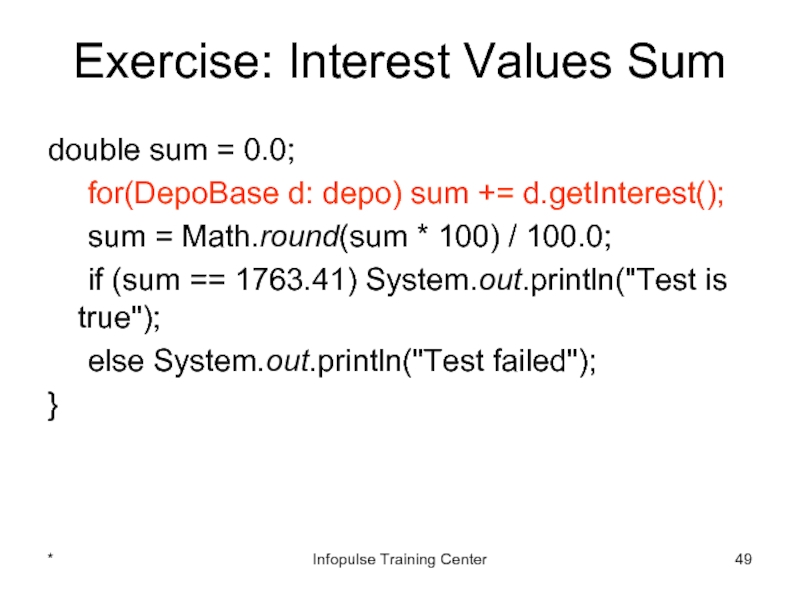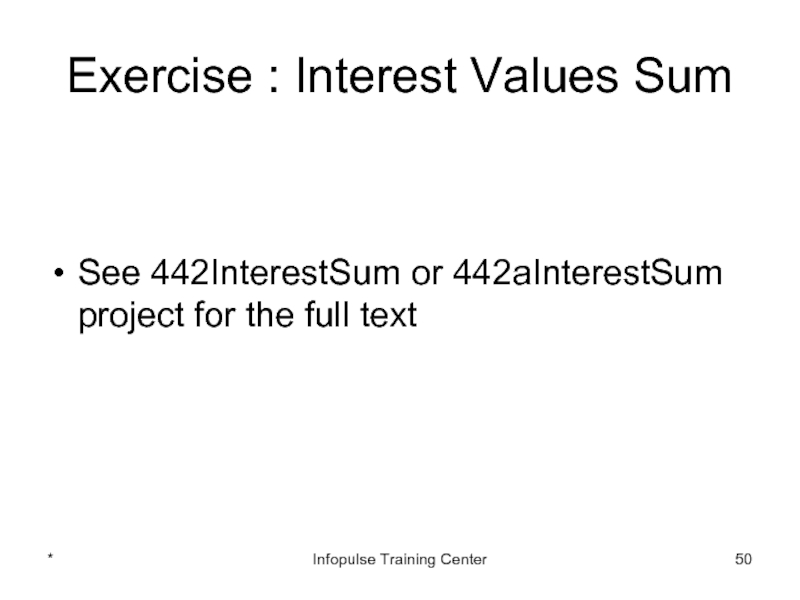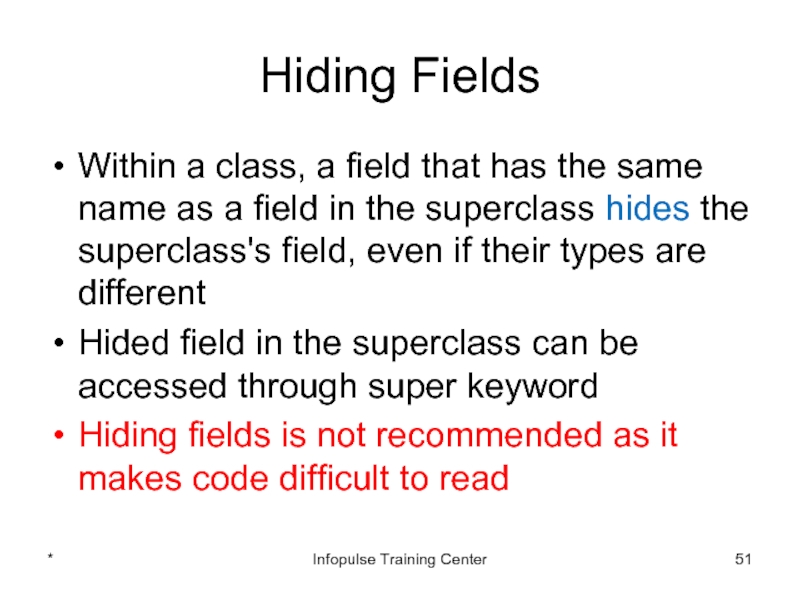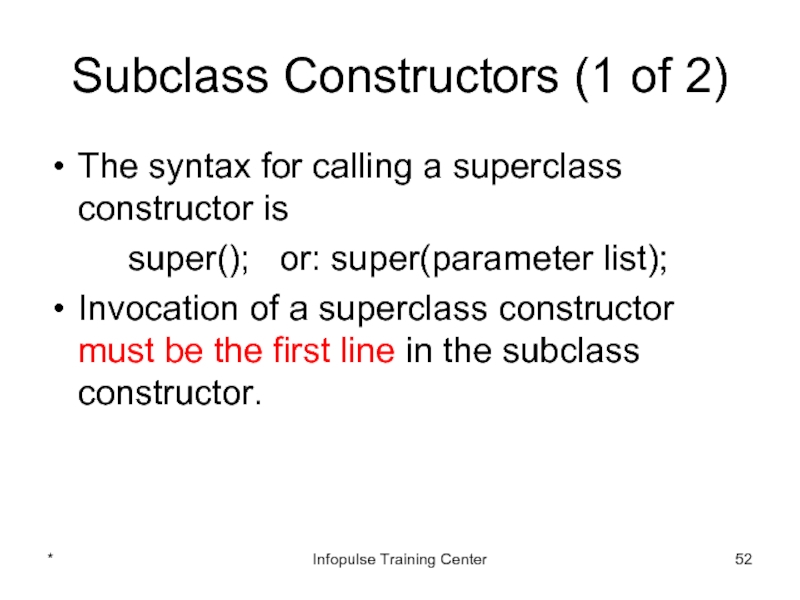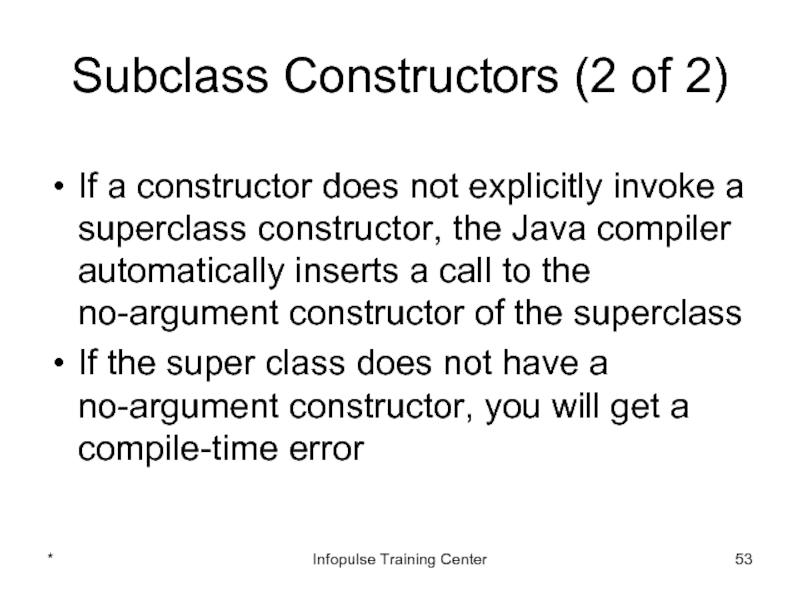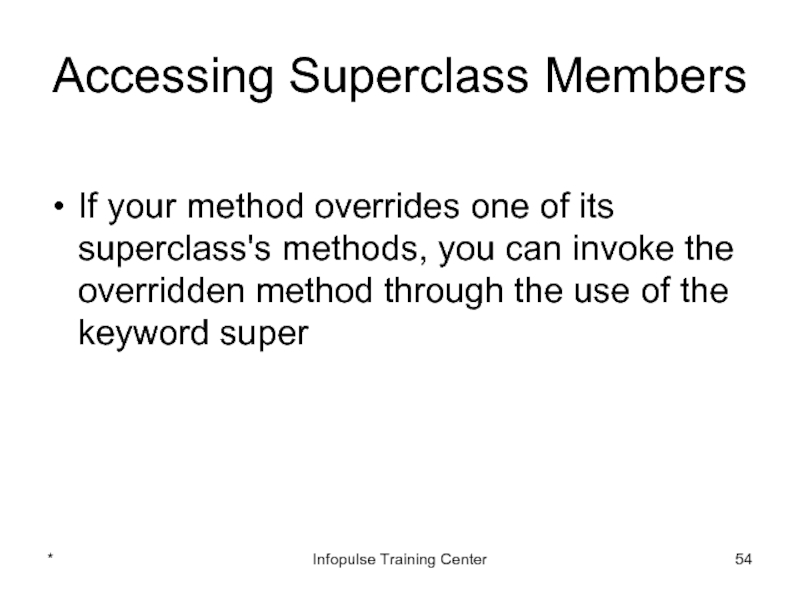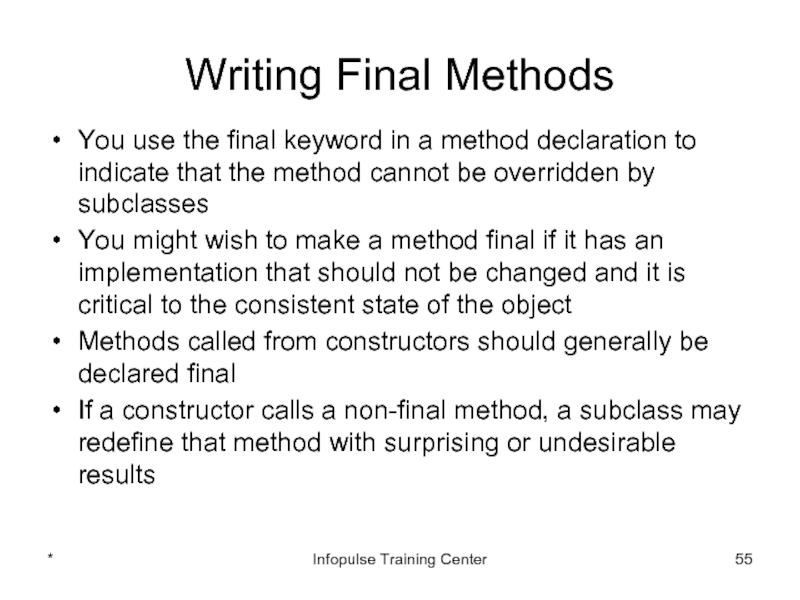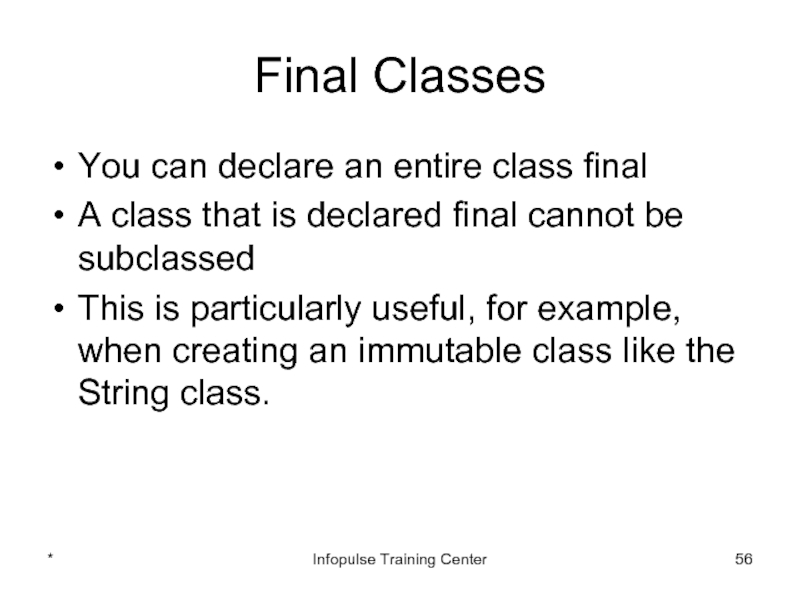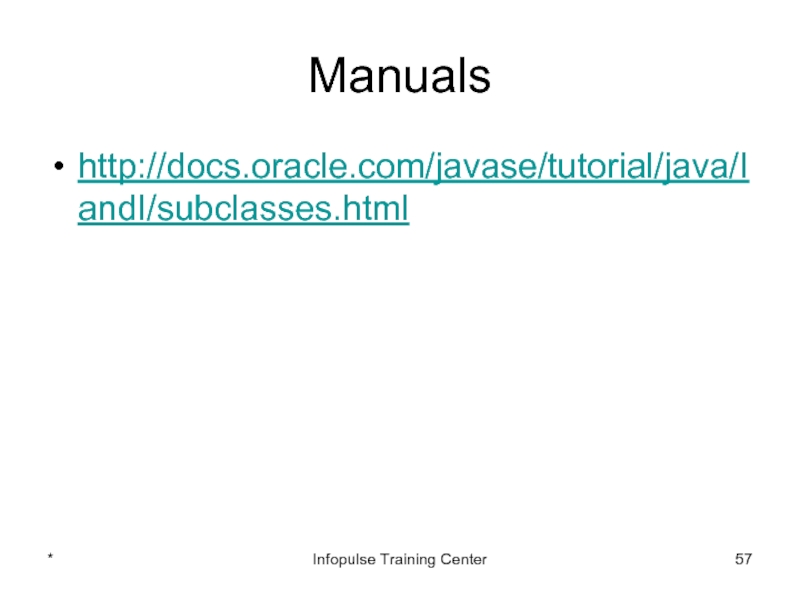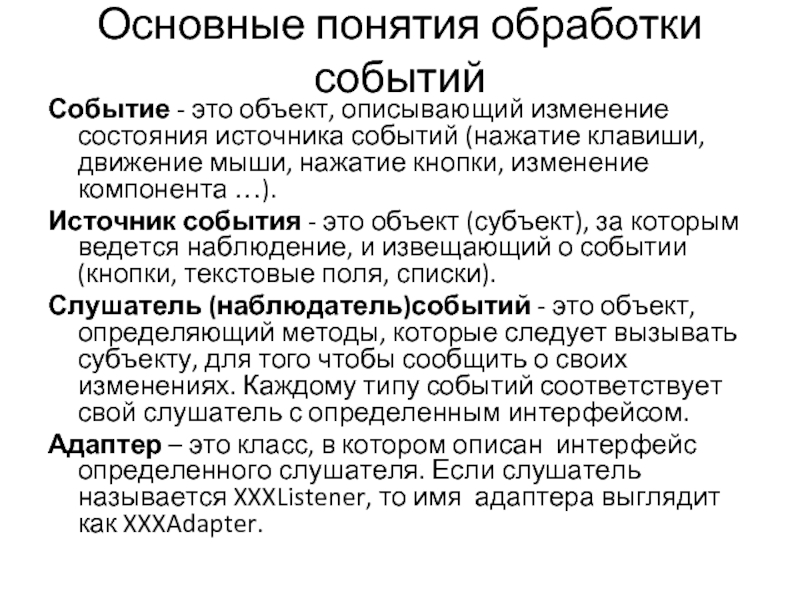- Главная
- Разное
- Дизайн
- Бизнес и предпринимательство
- Аналитика
- Образование
- Развлечения
- Красота и здоровье
- Финансы
- Государство
- Путешествия
- Спорт
- Недвижимость
- Армия
- Графика
- Культурология
- Еда и кулинария
- Лингвистика
- Английский язык
- Астрономия
- Алгебра
- Биология
- География
- Детские презентации
- Информатика
- История
- Литература
- Маркетинг
- Математика
- Медицина
- Менеджмент
- Музыка
- МХК
- Немецкий язык
- ОБЖ
- Обществознание
- Окружающий мир
- Педагогика
- Русский язык
- Технология
- Физика
- Философия
- Химия
- Шаблоны, картинки для презентаций
- Экология
- Экономика
- Юриспруденция
4. Java OOP. 4. Inheritance and Polymorphism презентация
Содержание
- 1. 4. Java OOP. 4. Inheritance and Polymorphism
- 2. Inheritance Basics (1 of 3) Classes can
- 3. Inheritance Basics (2 of 3) A class
- 4. Inheritance Basics (3 of 3) A subclass
- 5. Members Inheritance A subclass inherits all of
- 6. Fields Inheritance The inherited fields can be
- 7. What will be the output? class A{
- 8. What will be the output? class A{
- 9. What will be the output? class A{
- 10. What will be the output? class A{
- 11. What will be the output? class A{
- 12. What will be the output? class A{
- 13. Methods Inheritance The inherited methods can be
- 14. What will be the output? class A{
- 15. What will be the output? class A{
- 16. Methods Overriding and Hiding You can write
- 17. Constructors Call You can write a subclass
- 18. Private Members in a Superclass A subclass
- 19. Exercise 4.4.1: DepoBase class Modify 433DepoMonthCapitalize, 432DepoBarrier,
- 20. DepoBase Class (1 of 2) public class
- 21. DepoBase Class (2 of 2) // accessors
- 22. DepoSimple Class public class DepoSimple extends DepoBase{
- 23. Exercise 4.4.1: DepoBase class See 441DepoBase projects
- 24. Casting Objects (1 of 3) Casting shows
- 25. Casting Objects (2 of 3) We can
- 26. Casting Objects (3 of 3) You
- 27. What will be the output? class A{
- 28. What will be the output? class A{
- 29. What will be the output? class A{
- 30. What will be the output? class A{
- 31. What will be the output? class A{
- 32. What will be the output? class A{
- 33. What will be the output? class A{
- 34. What will be the output? class A{
- 35. Overriding Instance Methods I An instance method
- 36. Overriding Instance Methods II When overriding a
- 37. What will be the output? class A{
- 38. What will be the output? class A{
- 39. Hiding Static Methods (1 of 6) public
- 40. Hiding Static Methods (2 of 6) public
- 41. Hiding Static Methods (3 of 6) public
- 42. Hiding Static Methods (4 of 6) Output:
- 43. Hiding Static Methods (5 of 6) public
- 44. Hiding Static Methods (6 of 6) Output:
- 45. Polymorphism (1 of 2) Connecting a method
- 46. Polymorphism (2 of 2) All method binding
- 47. Exercise 4.4.2 Create a deposit array of
- 48. Exercise: Interest Values Sum Date start =
- 49. Exercise: Interest Values Sum double sum =
- 50. Exercise : Interest Values Sum See 442InterestSum
- 51. Hiding Fields Within a class, a field
- 52. Subclass Constructors (1 of 2) The syntax
- 53. Subclass Constructors (2 of 2) If a
- 54. Accessing Superclass Members If your method overrides
- 55. Writing Final Methods You use the final
- 56. Final Classes You can declare an entire
- 57. Manuals http://docs.oracle.com/javase/tutorial/java/IandI/subclasses.html * Infopulse Training Center
Слайд 2Inheritance Basics (1 of 3)
Classes can be derived from other classes,
class Sub extends Sup {
…
}
*
Infopulse Training Center
Слайд 3Inheritance Basics (2 of 3)
A class that is derived from another
The class from which the subclass is derived is called a superclass (also a base class or a parent class).
Every class has one and only one direct superclass (single inheritance).
Class Object is exception, it is a root class
*
Infopulse Training Center
Слайд 4Inheritance Basics (3 of 3)
A subclass inherits all the members (fields,
Constructors are not members, so they are not inherited by subclasses
The constructor of the superclass can be invoked from the subclass
*
Infopulse Training Center
Слайд 5Members Inheritance
A subclass inherits all of the public and protected members
If the subclass is in the same package as its parent, it also inherits the package-private members of the parent.
You can use the inherited members as is, replace them, hide them, or supplement them with new members
*
Infopulse Training Center
Слайд 6Fields Inheritance
The inherited fields can be used directly
You can declare a
You can declare new fields in the subclass that are not in the superclass.
*
Infopulse Training Center
Слайд 7What will be the output?
class A{
int v1 = 8;
private String s = “1234”;
}
class B extends A{
public void doSomething(){
System.out.println(s);
}
*
Infopulse Training Center
Class C{
public static void main(String[] args) {
B obj = new B();
obj.doSomething();
}
}
Слайд 8What will be the output?
class A{
int v1 = 8;
private String s = “1234”;
}
class B extends A{
public void doSomething(){
System.out.println(s);
}
*
Infopulse Training Center
Class C{
public static void main(String[] args) {
B obj = new B();
obj.doSomething();
}
}
Compilation error
Слайд 9What will be the output?
class A{
int v1 = 8;
private String s = “1234”;
}
class B extends A{
public void doSomething(){
System.out.println(p);
}
*
Infopulse Training Center
Class C{
public static void main(String[] args) {
B obj = new B();
obj.doSomething();
}
}
Слайд 10What will be the output?
class A{
int v1 = 8;
private String s = “1234”;
}
class B extends A{
public void doSomething(){
System.out.println(p);
}
*
Infopulse Training Center
Class C{
public static void main(String[] args) {
B obj = new B();
obj.doSomething();
}
}
-5.0
Слайд 11What will be the output?
class A{
int v1 = 8;
private String s = “1234”;
}
class B extends A{
public void doSomething(){
System.out.println(v1);
}
*
Infopulse Training Center
Class C{
public static void main(String[] args) {
B obj = new B();
obj.doSomething();
}
}
Слайд 12What will be the output?
class A{
int v1 = 8;
private String s = “1234”;
}
class B extends A{
public void doSomething(){
System.out.println(v1);
}
*
Infopulse Training Center
Class C{
public static void main(String[] args) {
B obj = new B();
obj.doSomething();
}
}
8 if B and A in the same package; Compilation error otherwise
Слайд 13Methods Inheritance
The inherited methods can be used directly as they are.
You
*
Infopulse Training Center
Слайд 14What will be the output?
class A{
int v1 = 8;
System.out.println(v1);
}
}
class B extends A{
public void doSomething(){
System.out.println(2 * v1);
}
*
Infopulse Training Center
Class C{
public static void main(String[] args) {
B obj = new B();
obj.printV1();
obj.doSomething();
}
}
Слайд 15What will be the output?
class A{
int v1 = 8;
System.out.println(v1);
}
}
class B extends A{
public void doSomething(){
System.out.println(2 * v1);
}
*
Infopulse Training Center
Class C{
public static void main(String[] args) {
B obj = new B();
obj.printV1();
obj.doSomething();
}
}
8 16
Слайд 16Methods Overriding and Hiding
You can write a new instance method in
You can write a new static method in the subclass that has the same signature as the one in the superclass, thus hiding it.
*
Infopulse Training Center
Слайд 17Constructors Call
You can write a subclass constructor that invokes the constructor
*
Infopulse Training Center
Слайд 18Private Members in a Superclass
A subclass does not inherit the private
However, if the superclass has public or protected methods for accessing its private fields, these can also be used by the subclass.
*
Infopulse Training Center
Слайд 19Exercise 4.4.1: DepoBase class
Modify 433DepoMonthCapitalize, 432DepoBarrier, and 431SimpleDepo projects with help
*
Infopulse Training Center
Слайд 20DepoBase Class (1 of 2)
public class DepoBase {
protected Date startDate;
protected int
protected double sum;
protected double interestRate;
public DepoBase() {}
public DepoBase(Date startDate, int dayLong, double sum,
double interestRate){
this.startDate = startDate;
this.dayLong = dayLong;
this.sum = sum;
this.interestRate = interestRate; }
Слайд 21DepoBase Class (2 of 2)
// accessors
public double calculateInterest(LocalDate start, LocalDate maturity){
int
int maturityYear = maturity.getYear();
. . . . . . . . . .
double dayCf = start.until(maturity, ChronoUnit.DAYS)
+ 1;
double interest = sum * (interestRate / 100.0) *
(dayCf / daysInYear);
return interest;
}
Слайд 22DepoSimple Class
public class DepoSimple extends DepoBase{
public DepoSimple(){ }
public DepoSimple(Date startDate,
super(startDate, dayLong, sum, interestRate);
}
public double getInterest(){
double interest = 0.0;
. . . . . . . . . . . .
return interest;
}
*
Infopulse Training Center
Слайд 23Exercise 4.4.1: DepoBase class
See 441DepoBase projects for the full text
*
Infopulse Training
Слайд 24Casting Objects (1 of 3)
Casting shows the use of an object
Object obj = new ClassName();
If, on the other hand, we write
ClassName cn = obj;
we would get a compile-time error because
obj is not known to the compiler to be a
ClassName
*
Infopulse Training Center
Слайд 25Casting Objects (2 of 3)
We can tell the compiler to assign
This cast inserts a runtime check that obj is assigned a ClassName so that the compiler can safely assume that obj is a ClassName
If obj is not a ClassName at runtime, a ClassCastException will be thrown.
*
Infopulse Training Center
Слайд 26Casting Objects (3 of 3)
You can make a logical test
if (obj instanceof ClassName) {
ClassName myBike = (ClassName)obj;
}
The test x instanceof C does not generate an exception if x is null. It simply returns false.
*
Infopulse Training Center
Слайд 27What will be the output?
class A{
int v1 = 8;
System.out.println(v1);
}
}
class B extends A{
public void doSomething(){
System.out.println(2 * v1);
}
*
Infopulse Training Center
Class C{
public static void main(String[] args) {
A obj = new B();
obj.printV1();
obj.doSomething();
}
}
Слайд 28What will be the output?
class A{
int v1 = 8;
System.out.println(v1);
}
}
class B extends A{
public void doSomething(){
System.out.println(2 * v1);
}
*
Infopulse Training Center
Class C{
public static void main(String[] args) {
A obj = new B();
obj.printV1();
obj.doSomething();
}
}
Compilation error “Undefined method” on line obj.doSomething();
Слайд 29What will be the output?
class A{
int v1 = 8;
System.out.println(v1);
}
}
class B extends A{
public void doSomething(){
System.out.println(2 * v1);
}
*
Infopulse Training Center
Class C{
public static void main(String[] args) {
B obj = new A();
obj.printV1();
obj.doSomething();
}
}
Слайд 30What will be the output?
class A{
int v1 = 8;
System.out.println(v1);
}
}
class B extends A{
public void doSomething(){
System.out.println(2 * v1);
}
*
Infopulse Training Center
Class C{
public static void main(String[] args) {
B obj = new A();
obj.printV1();
obj.doSomething();
}
}
Compilation error “Type mismatch” on line B obj = new A();
Слайд 31What will be the output?
class A{
int v1 = 8;
System.out.println(v1);
}
}
class B extends A{
public void doSomething(){
System.out.println(2 * v1);
}
*
Infopulse Training Center
Class C{
public static void main(String[] args) {
B obj = (B)new A();
obj.printV1();
obj.doSomething();
}
}
Слайд 32What will be the output?
class A{
int v1 = 8;
System.out.println(v1);
}
}
class B extends A{
public void doSomething(){
System.out.println(2 * v1);
}
*
Infopulse Training Center
Class C{
public static void main(String[] args) {
B obj = (B)new A();
obj.printV1();
obj.doSomething();
}
}
Runtime error “ClassCastException” on line B obj = (B)new A();
Слайд 33What will be the output?
class A{
int v1 = 8;
System.out.println(v1);
}
}
class B extends A{
public void doSomething(){
System.out.println(2 * v1);
}
*
Infopulse Training Center
Class C{
public static void main(String[] args) {
B obj = new B();
A objA = obj;
objA.printV1();
}
}
Слайд 34What will be the output?
class A{
int v1 = 8;
System.out.println(v1);
}
}
class B extends A{
public void doSomething(){
System.out.println(2 * v1);
}
*
Infopulse Training Center
Class C{
public static void main(String[] args) {
B obj = new B();
A objA = obj;
objA.printV1();
}
}
8
Слайд 35Overriding Instance Methods I
An instance method in a subclass with the
The overriding method has the same name, number and type of parameters, and return type as the method it overrides.
An overriding method can also return a subtype of the type returned by the overridden method. This is called a covariant return type.
*
Infopulse Training Center
Слайд 36Overriding Instance Methods II
When overriding a method, you might want to
The access specifier for an overriding method can allow more, but not less, access than the overridden method (protected to public, but not to private)
*
Infopulse Training Center
Слайд 37What will be the output?
class A{
int v1 = 8;
System.out.println(v1);
}
}
class B extends A{
public void printV1(){
System.out.println(2 * v1);
}
*
Infopulse Training Center
Class C{
public static void main(String[] args) {
B obj = new B();
obj.printV1();
}
}
Слайд 38What will be the output?
class A{
int v1 = 8;
System.out.println(v1);
}
}
class B extends A{
public void printV1(){
System.out.println(2 * v1);
}
*
Infopulse Training Center
Class C{
public static void main(String[] args) {
B obj = new B();
obj.printV1();
}
}
16
Слайд 39Hiding Static Methods (1 of 6)
public class Animal {
public static
System.out.println("The class method in Animal.");
}
public void testInstanceMethod() {
System.out.println("The instance method in Animal.");
}
}
*
Infopulse Training Center
Слайд 40Hiding Static Methods (2 of 6)
public class Cat extends Animal {
public static void testClassMethod() {
System.out.println("The class method in Cat.");
}
public void testInstanceMethod() {
System.out.println("The instance method in Cat.");
}
}
*
Infopulse Training Center
Слайд 41Hiding Static Methods (3 of 6)
public static void main(String[] args) {
Animal myAnimal = new Animal();
Animal myAnimalCat = new Cat();
Cat myCat = new Cat();
myAnimal.testInstanceMethod();
myAnimalCat.testInstanceMethod();
myCat.testInstanceMethod();
}
*
Infopulse Training Center
Слайд 42Hiding Static Methods (4 of 6)
Output:
The instance method in Animal
The instance
The instance method in Cat
*
Infopulse Training Center
Слайд 43Hiding Static Methods (5 of 6)
public static void main(String[] args) {
Animal myAnimal = new Animal();
Animal myAnimalCat = new Cat();
Cat myCat = new Cat();
myAnimal.testClassMethod();
myAnimalCat.testClassMethod();
myCat. testClassMethod();
}
*
Infopulse Training Center
Слайд 44Hiding Static Methods (6 of 6)
Output:
The class method in Animal.
The class
The class method in Cat.
*
Infopulse Training Center
Слайд 45Polymorphism (1 of 2)
Connecting a method call to a method body
When binding is performed before the program is run (e.g. by the compiler), it’s called early binding.
Late binding means that the binding occurs at run time, based on the type of object
There must be some mechanism to determine the type of the object at run time and to call the appropriate method
*
Infopulse Training Center
Слайд 46Polymorphism (2 of 2)
All method binding in Java uses late binding
You can write your code to talk to the base class and know that all the derived-class cases will work correctly using the same code
Typical example: create an array of Base class and fill it with subclasses objects. Then you can call the same method for each object from array elements
*
Infopulse Training Center
Слайд 47Exercise 4.4.2
Create a deposit array of different types and calculate sum
*
Infopulse Training Center
Sum = 1763.41
Слайд 48Exercise: Interest Values Sum
Date start = new GregorianCalendar(2013, Calendar.SEPTEMBER, 8).getTime();
DepoBase[] depo
depo[0] = new DepoSimple(start, 20, 1000.0, 15.0);
depo[1] = new DepoSimple(start, 20, 2500.0, 18.0);
depo[2] = new DepoBarrier(start, 40, 15000.0, 11.5);
depo[3] = new DepoBarrier(start, 80, 5000.0, 14.0);
depo[4] = new DepoMonthCapitalize(start, 180, 2000.0, 16.5);
depo[5] = new DepoMonthCapitalize(start, 91, 40000.0, 12.1);
*
Infopulse Training Center
Слайд 49Exercise: Interest Values Sum
double sum = 0.0;
for(DepoBase d: depo) sum +=
sum = Math.round(sum * 100) / 100.0;
if (sum == 1763.41) System.out.println("Test is true");
else System.out.println("Test failed");
}
*
Infopulse Training Center
Слайд 50Exercise : Interest Values Sum
See 442InterestSum or 442aInterestSum project for the
*
Infopulse Training Center
Слайд 51Hiding Fields
Within a class, a field that has the same name
Hided field in the superclass can be accessed through super keyword
Hiding fields is not recommended as it makes code difficult to read
*
Infopulse Training Center
Слайд 52Subclass Constructors (1 of 2)
The syntax for calling a superclass constructor
super(); or: super(parameter list);
Invocation of a superclass constructor must be the first line in the subclass constructor.
*
Infopulse Training Center
Слайд 53Subclass Constructors (2 of 2)
If a constructor does not explicitly invoke
If the super class does not have a no-argument constructor, you will get a compile-time error
*
Infopulse Training Center
Слайд 54Accessing Superclass Members
If your method overrides one of its superclass's methods,
*
Infopulse Training Center
Слайд 55Writing Final Methods
You use the final keyword in a method declaration
You might wish to make a method final if it has an implementation that should not be changed and it is critical to the consistent state of the object
Methods called from constructors should generally be declared final
If a constructor calls a non-final method, a subclass may redefine that method with surprising or undesirable results
*
Infopulse Training Center
Слайд 56Final Classes
You can declare an entire class final
A class that is
This is particularly useful, for example, when creating an immutable class like the String class.
*
Infopulse Training Center
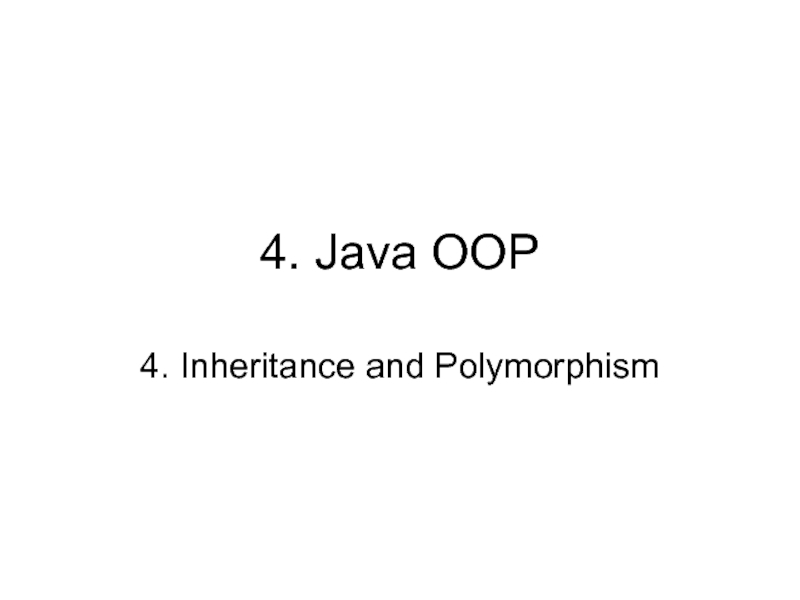
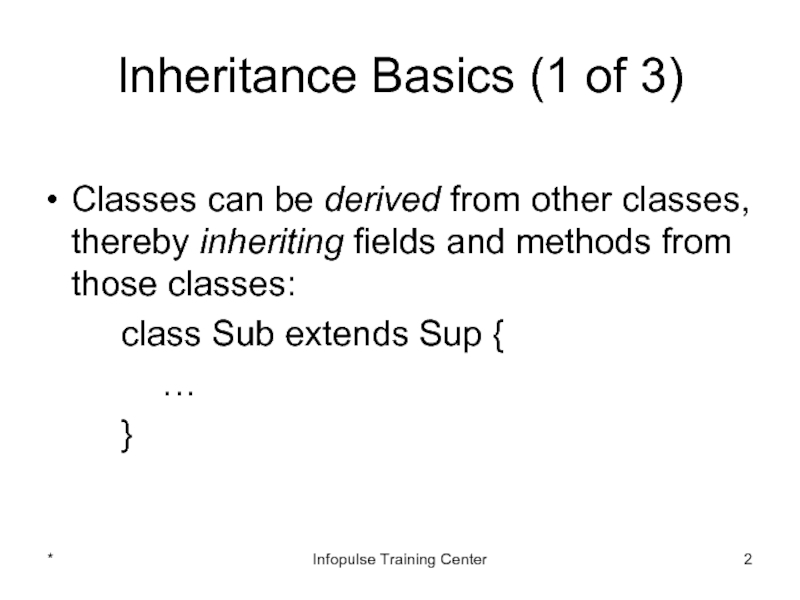
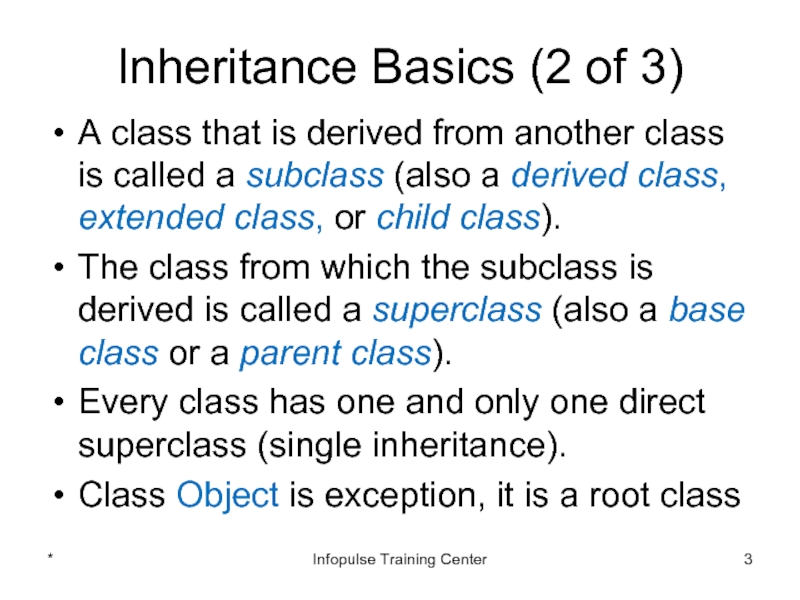
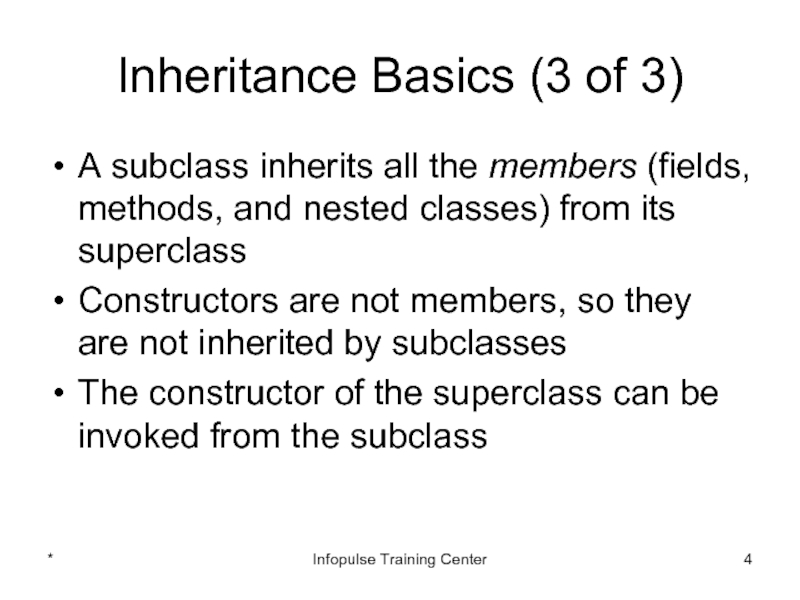
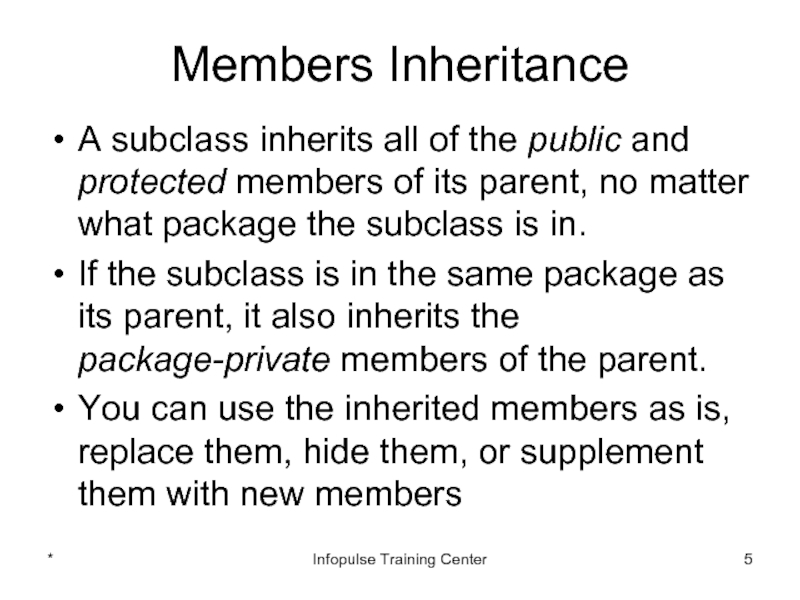
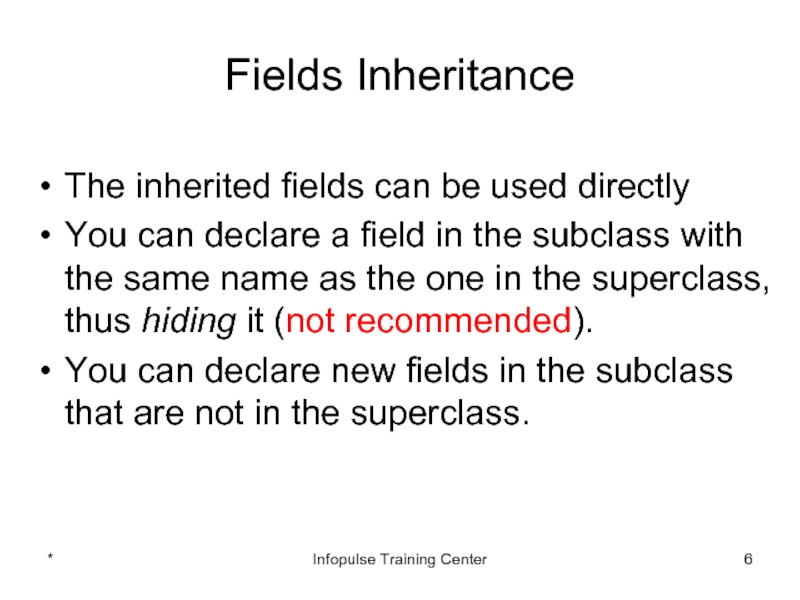

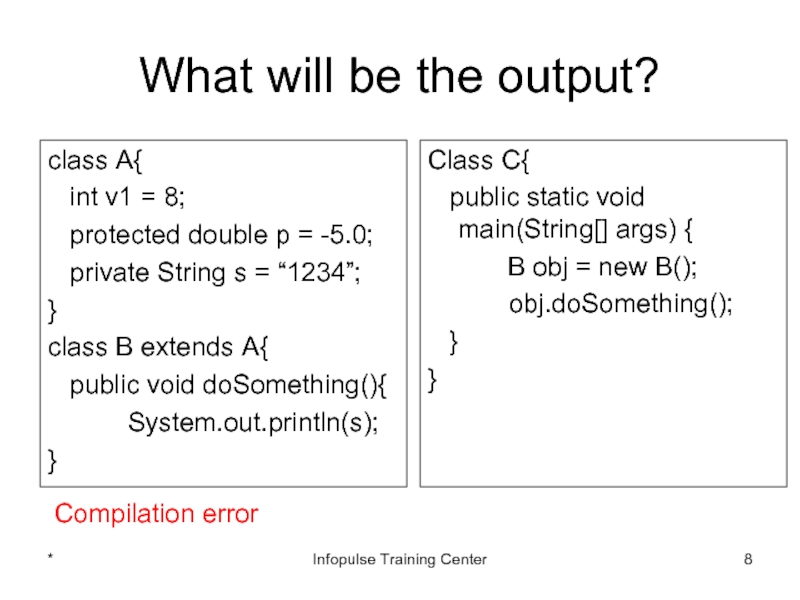
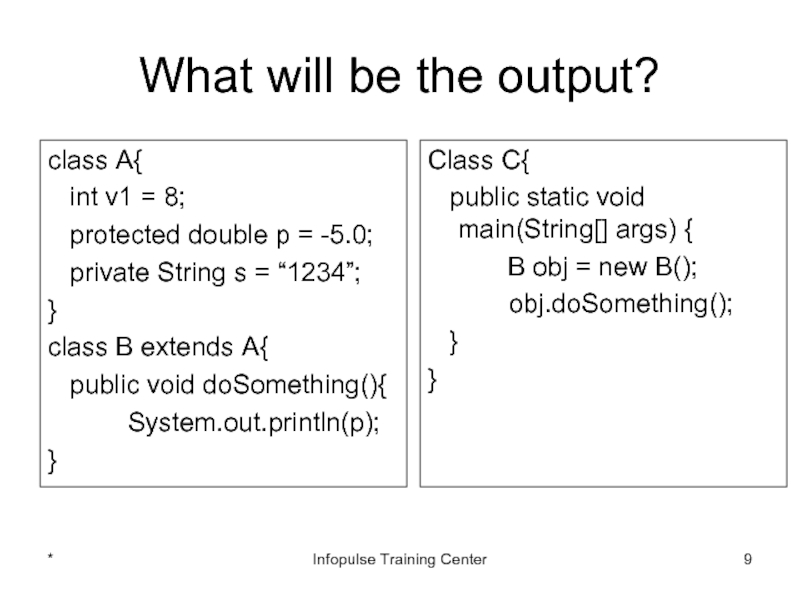
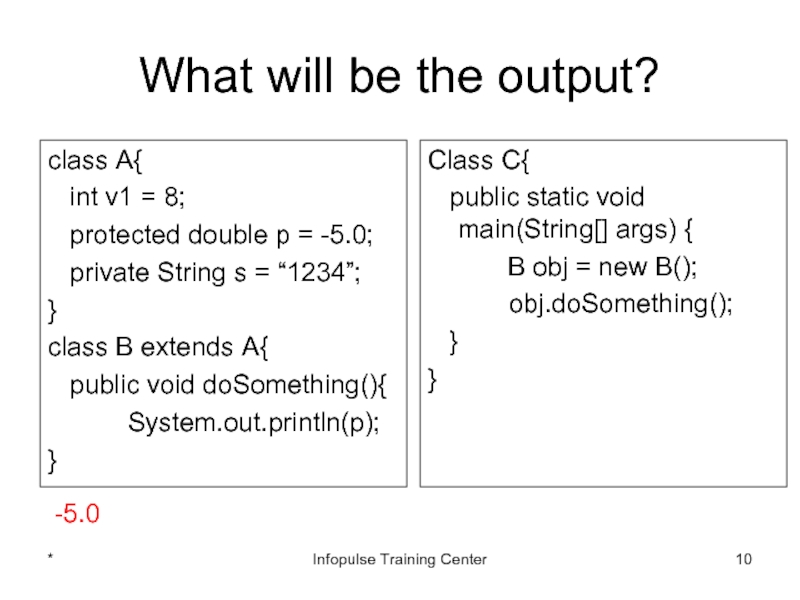
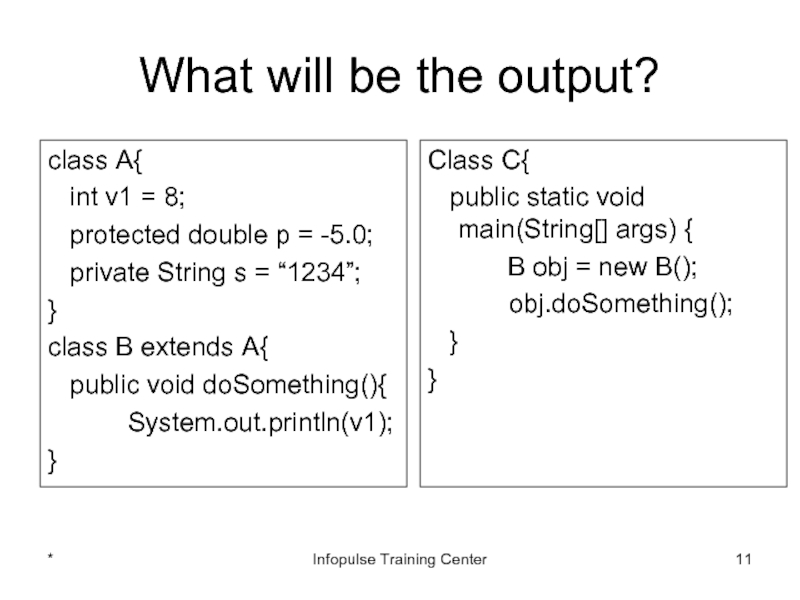
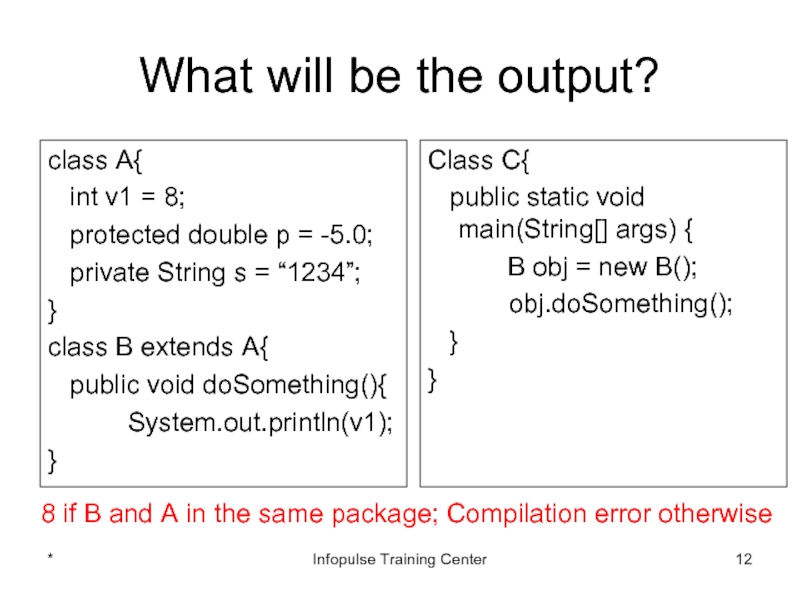
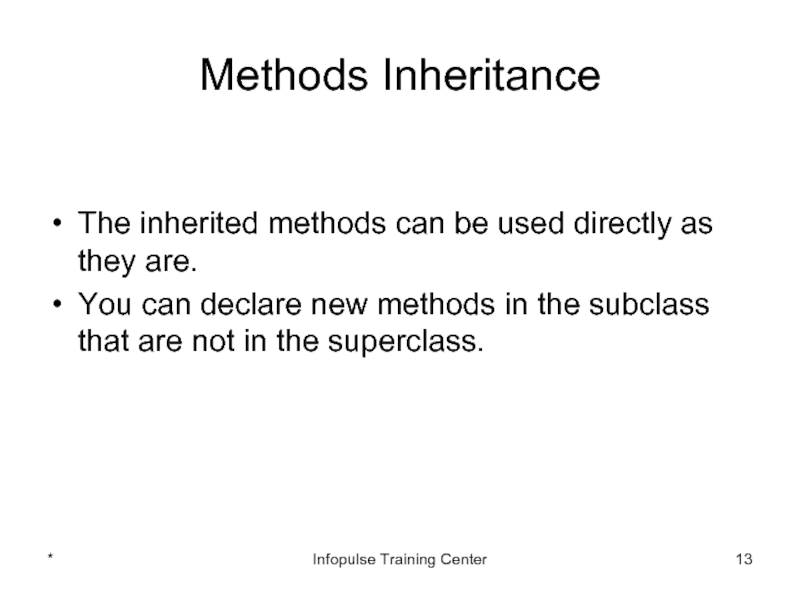
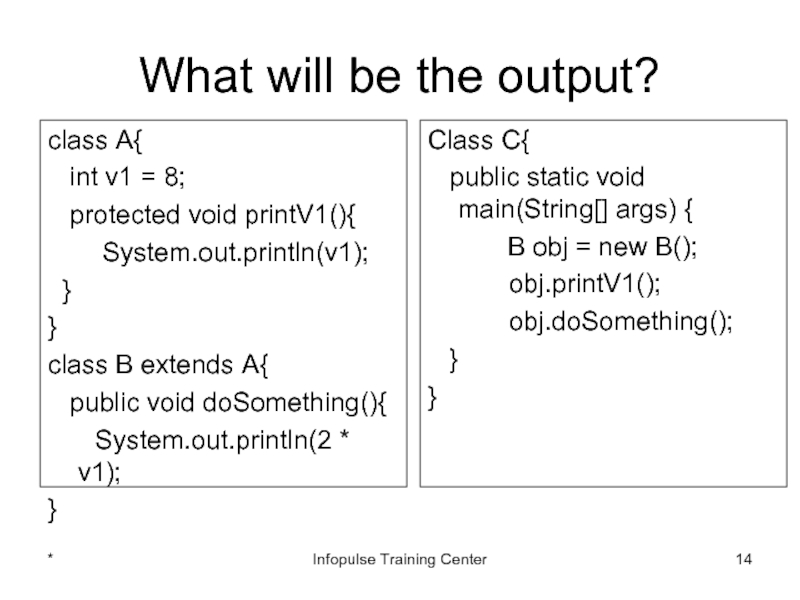
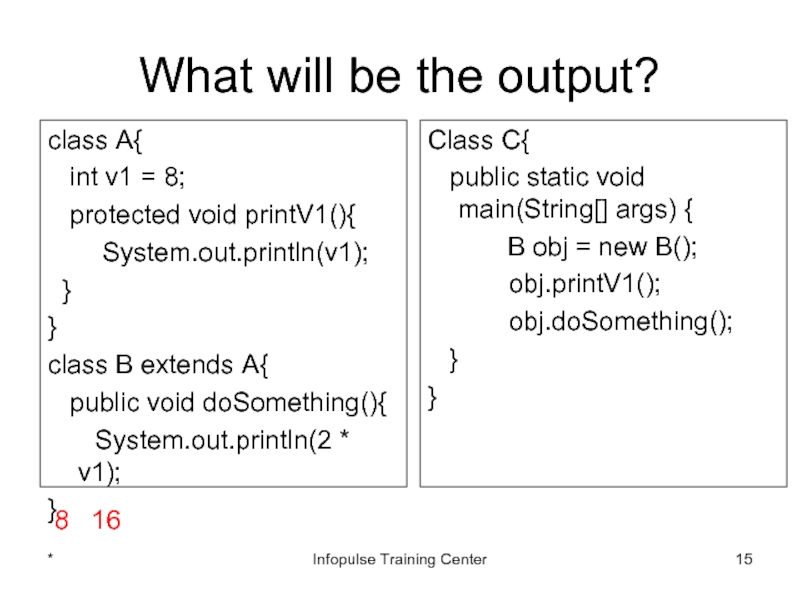
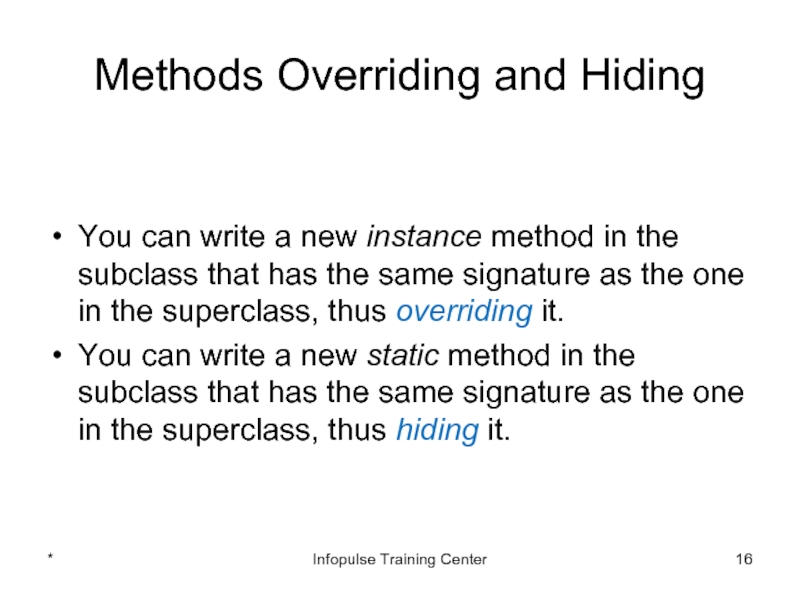
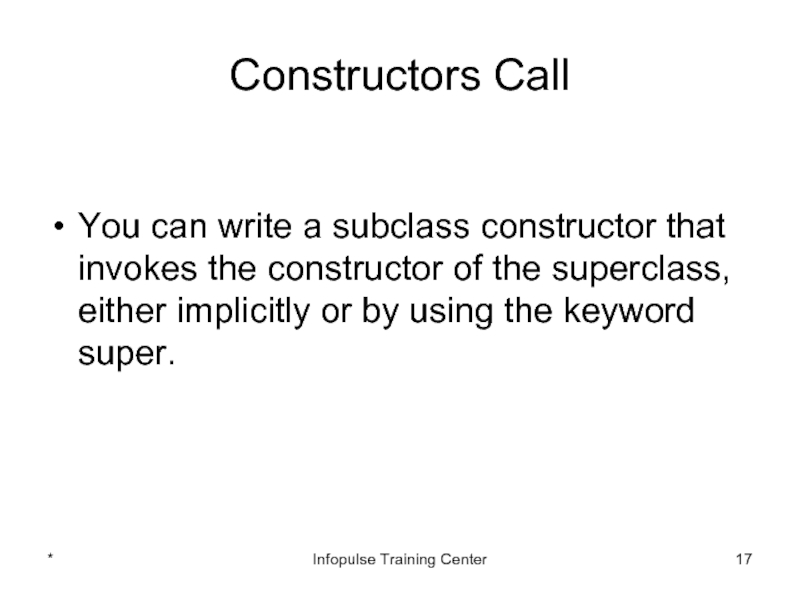
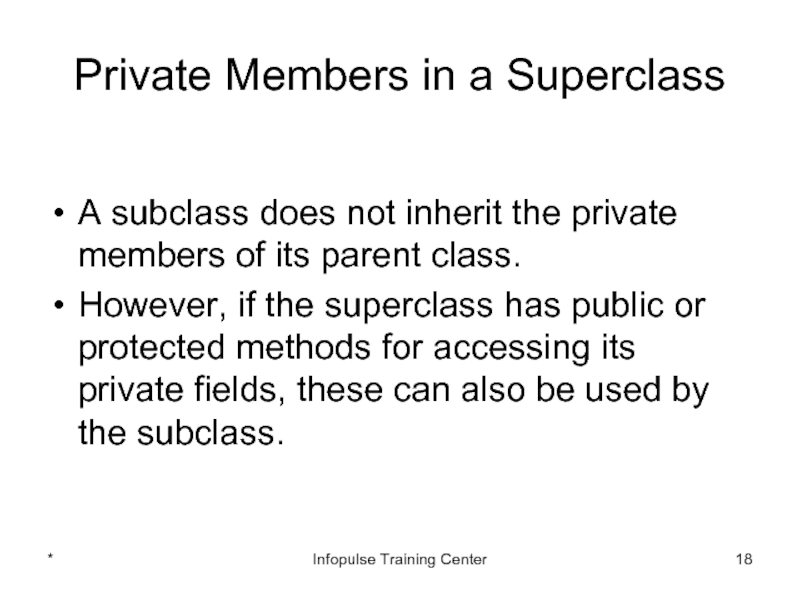
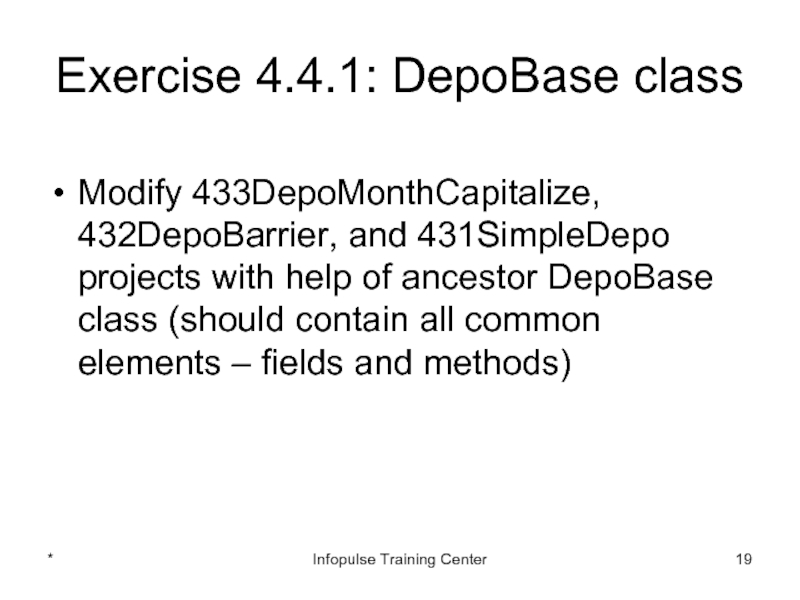
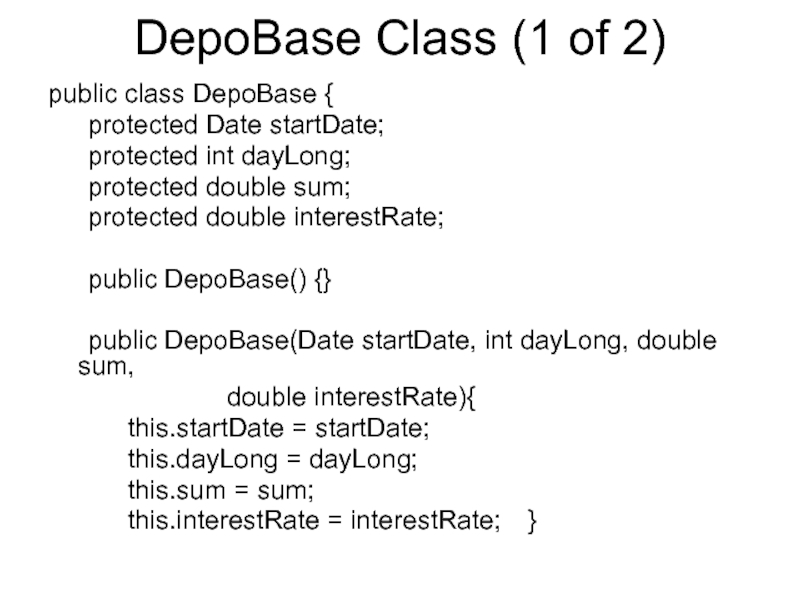
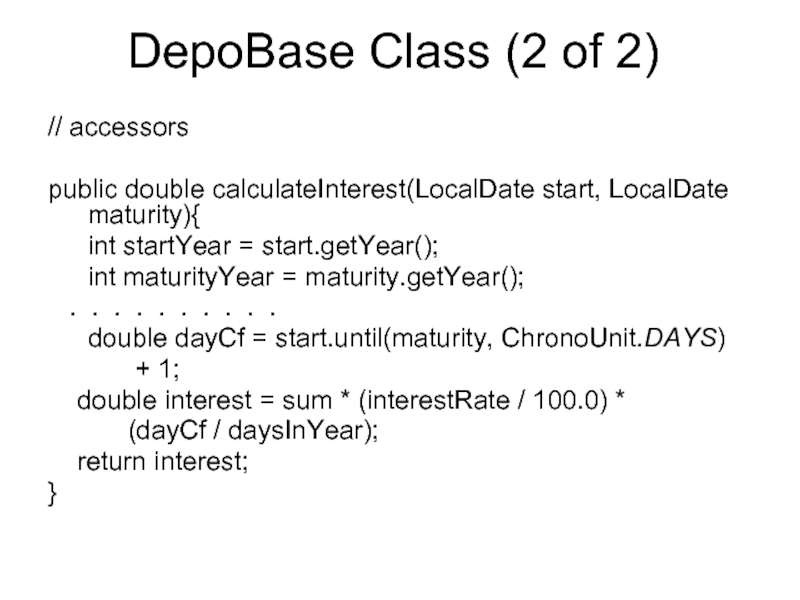
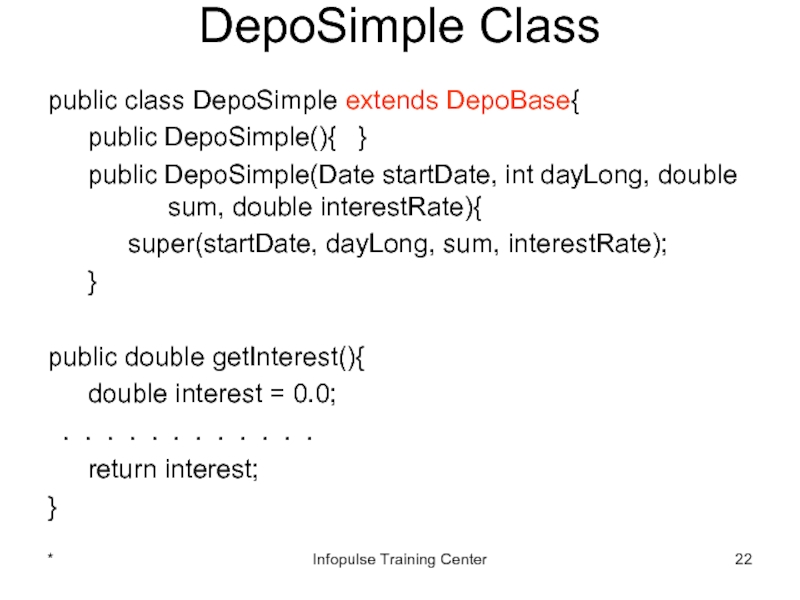
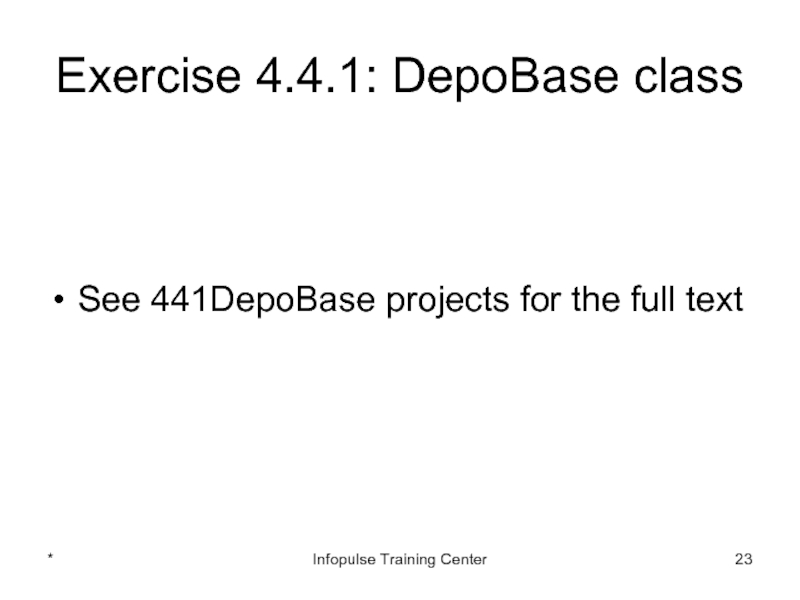
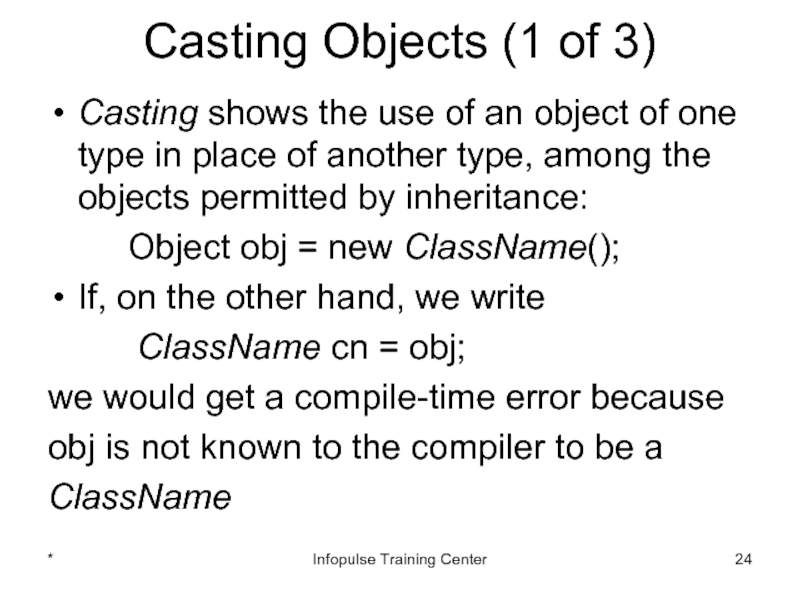
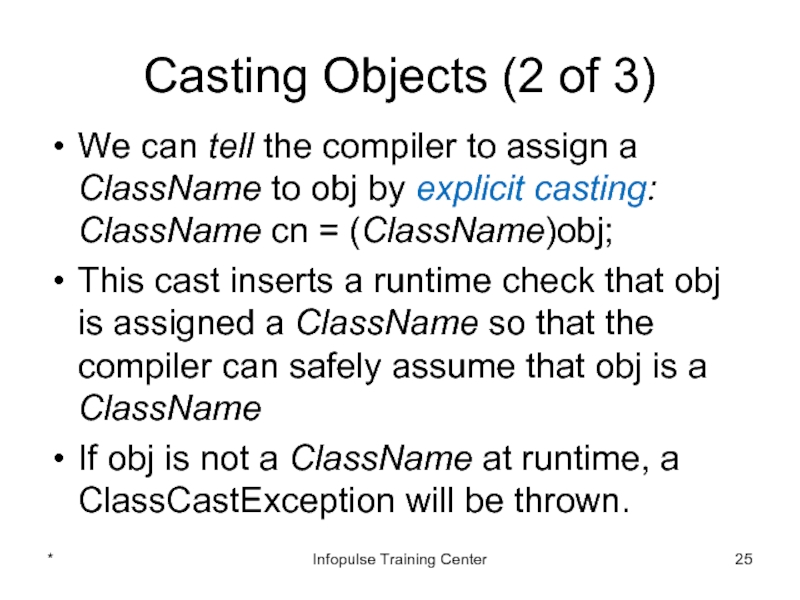
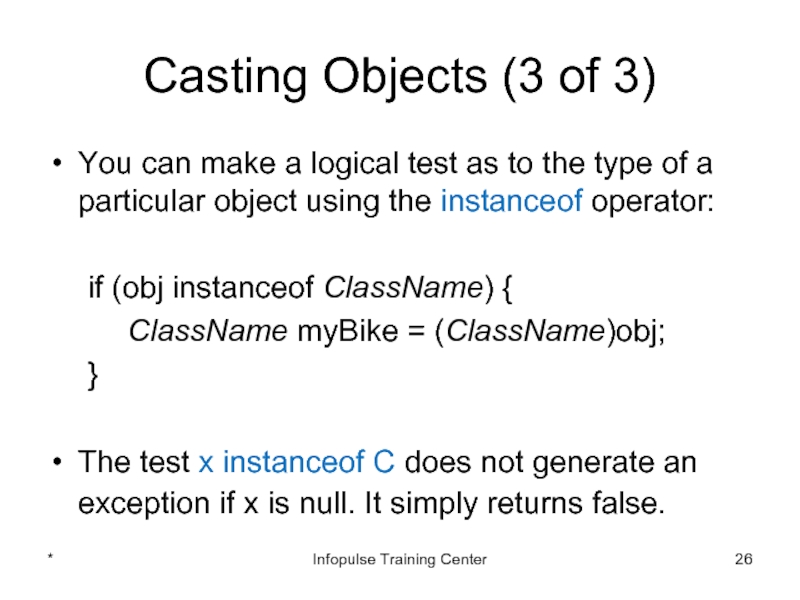
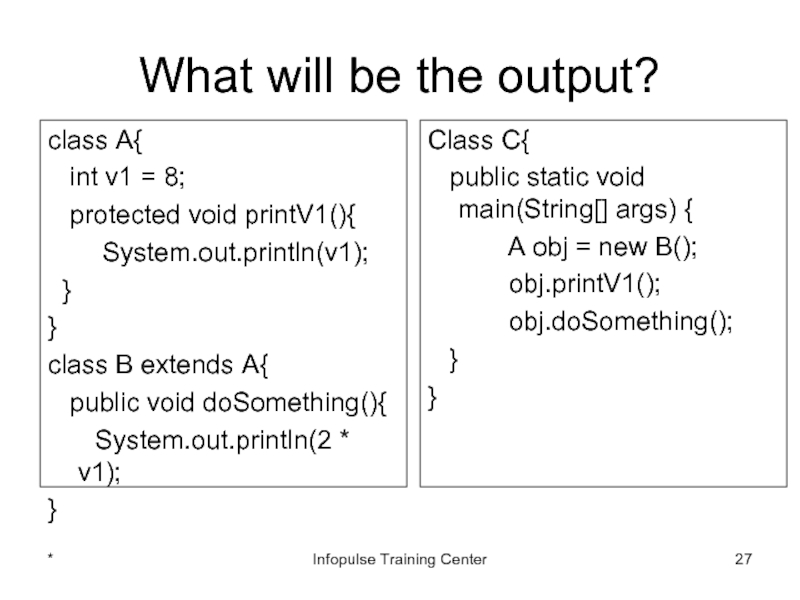
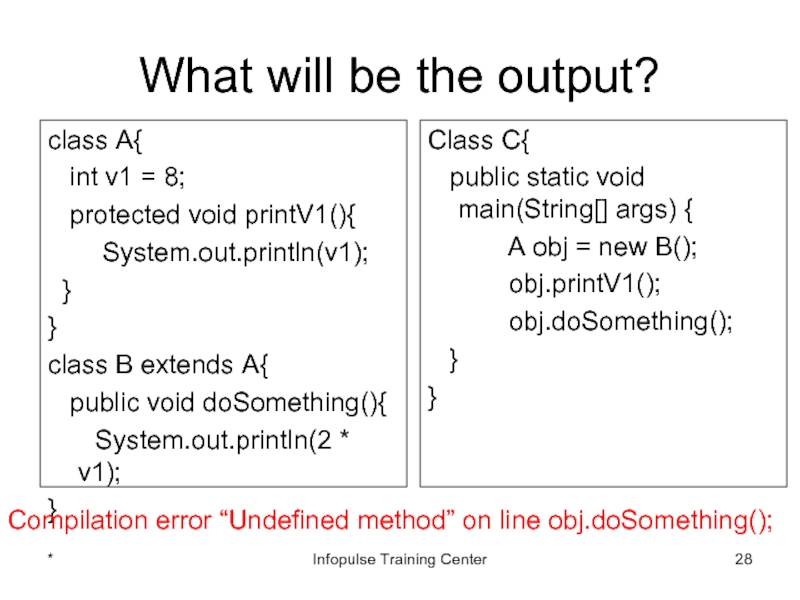
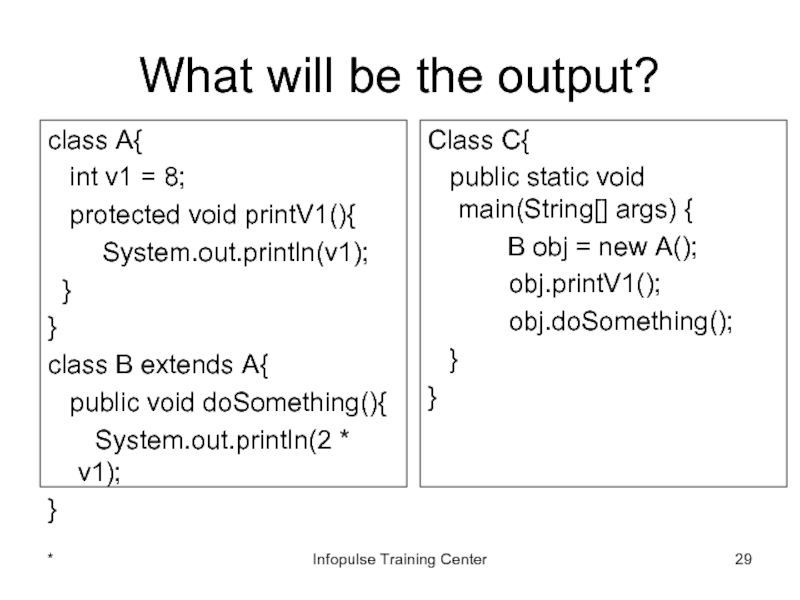
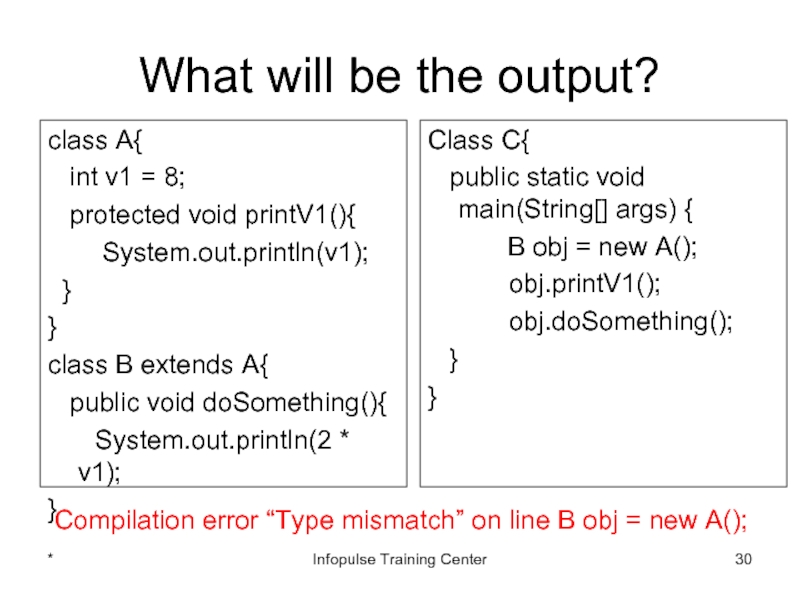
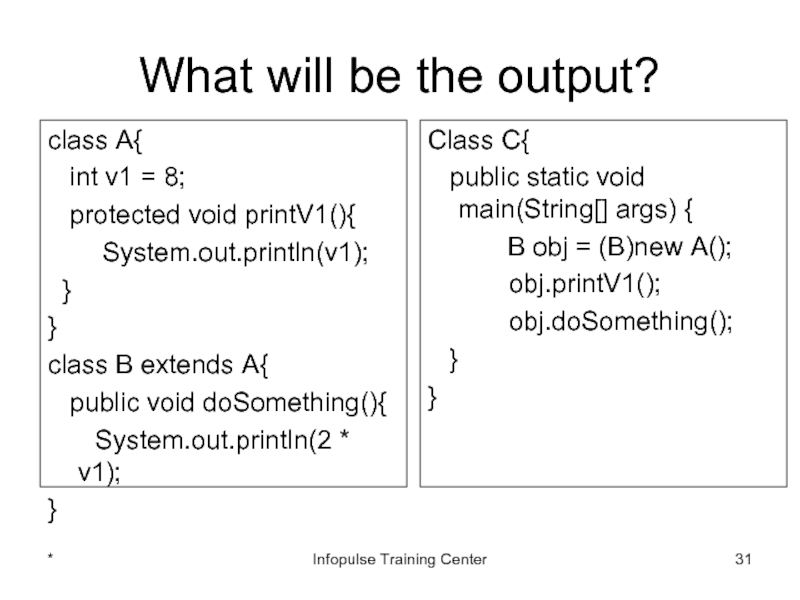
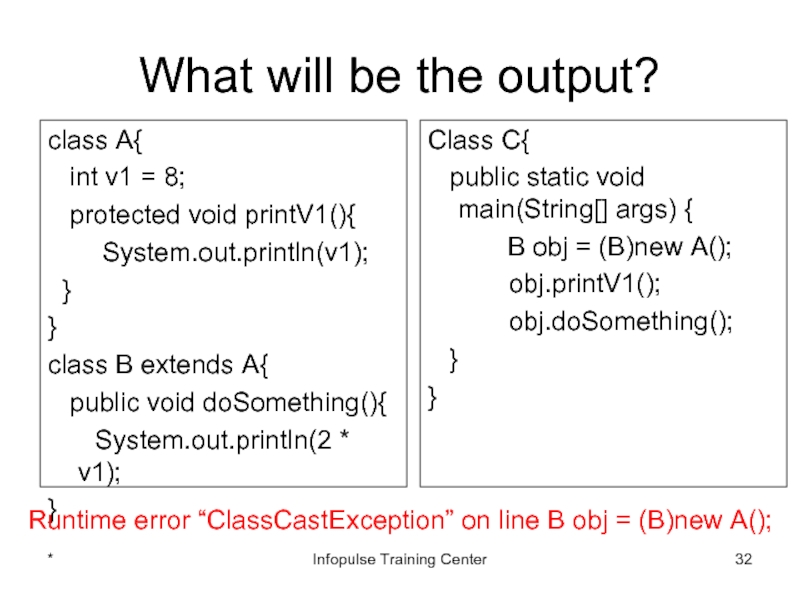
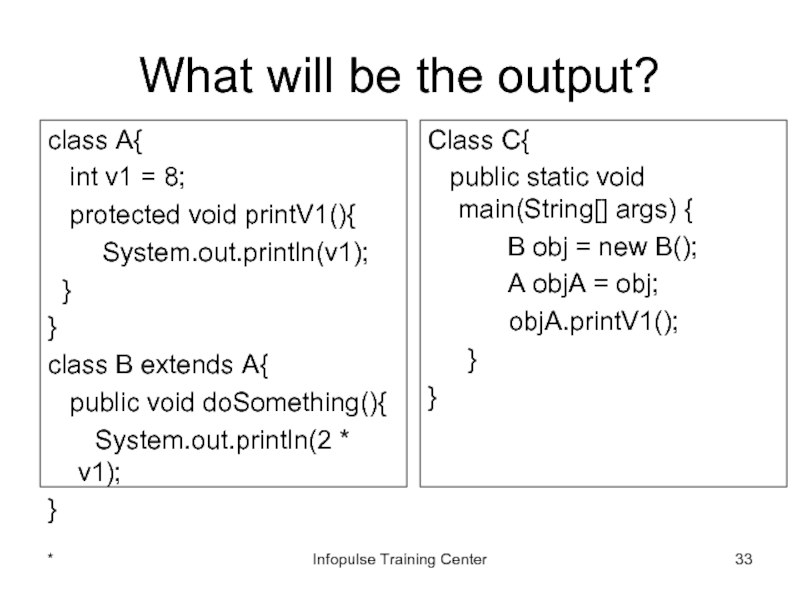
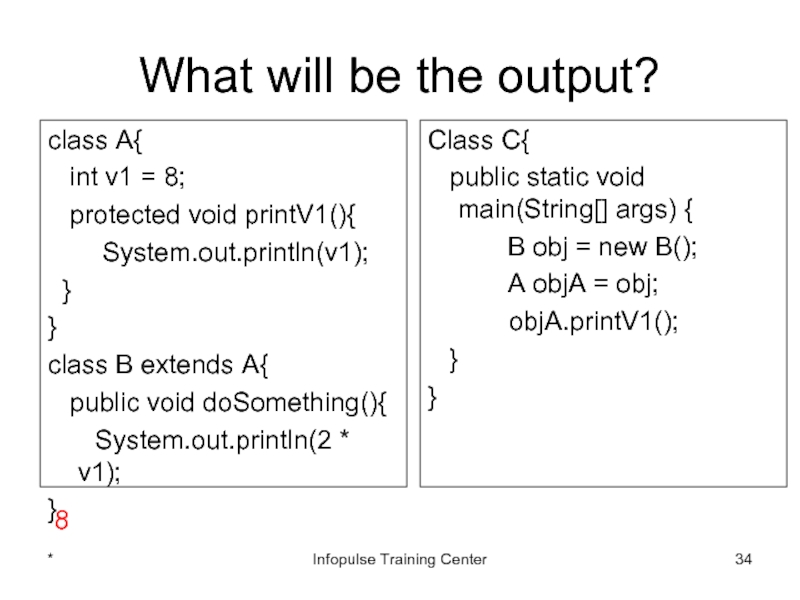
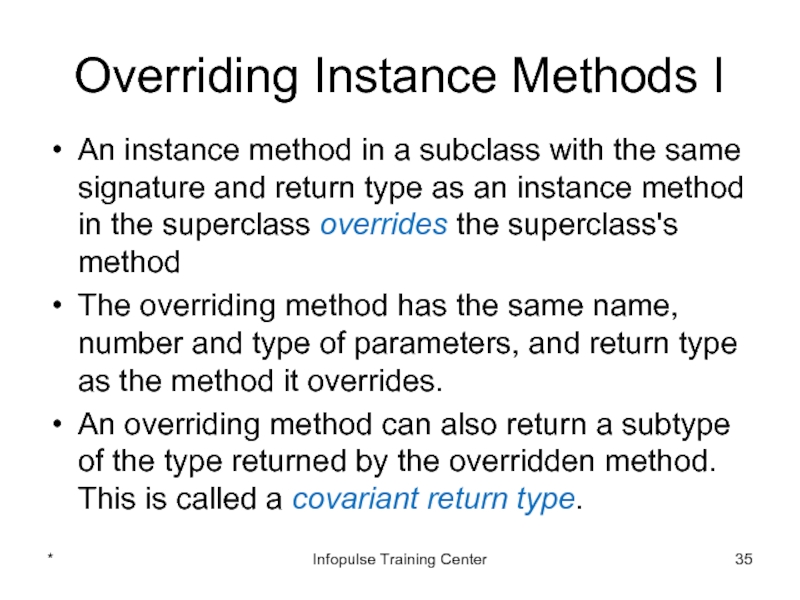
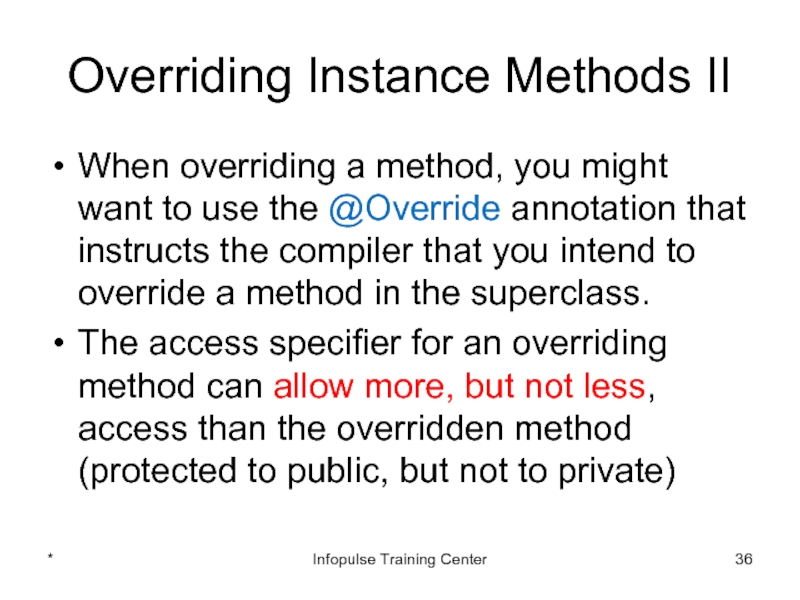
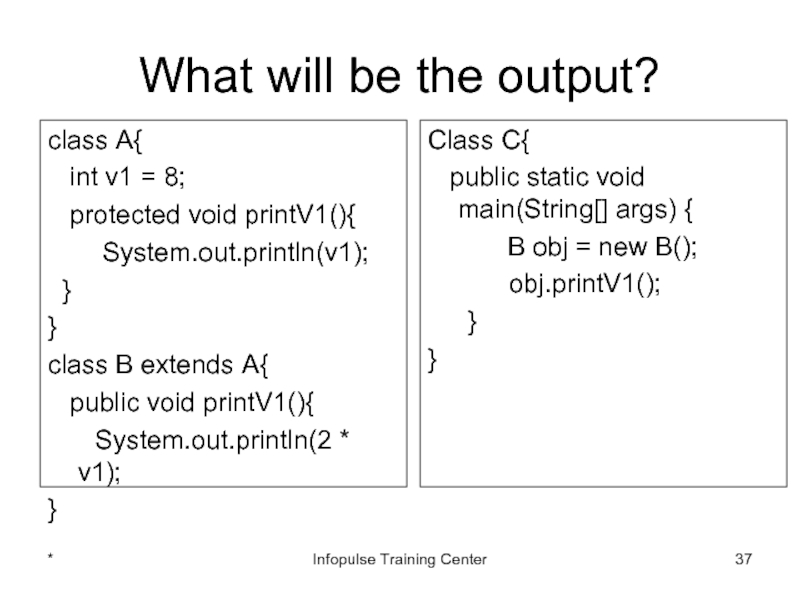
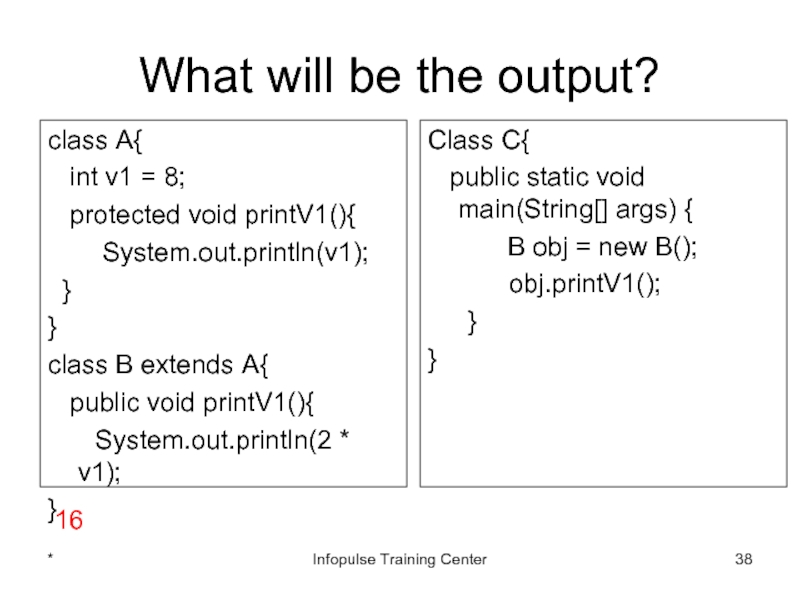
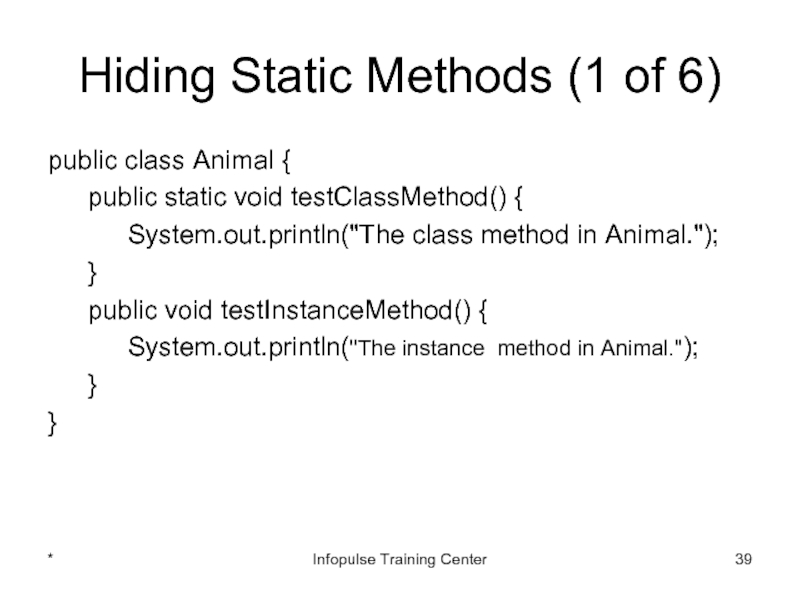
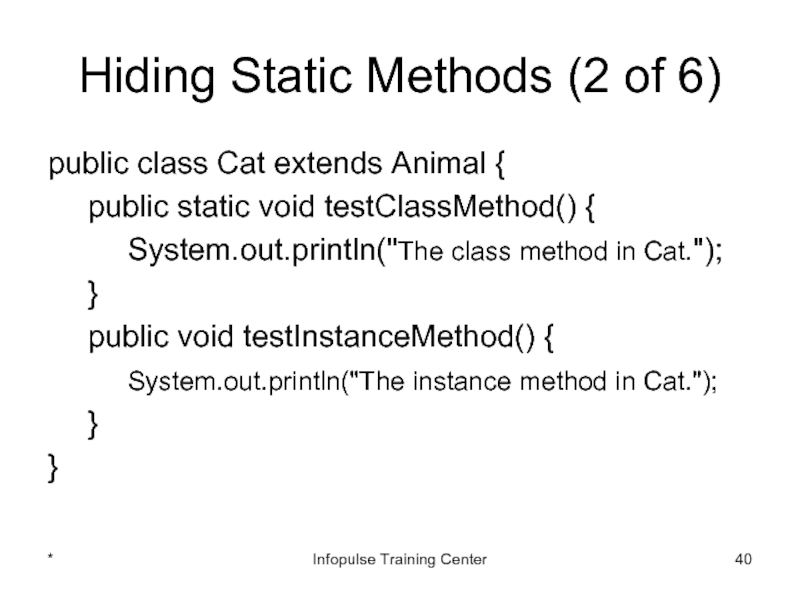
![Hiding Static Methods (3 of 6)public static void main(String[] args) { Animal myAnimal = new](/img/tmb/1/32371/8bca510f401cb8e49c7abf93dc16142e-800x.jpg)
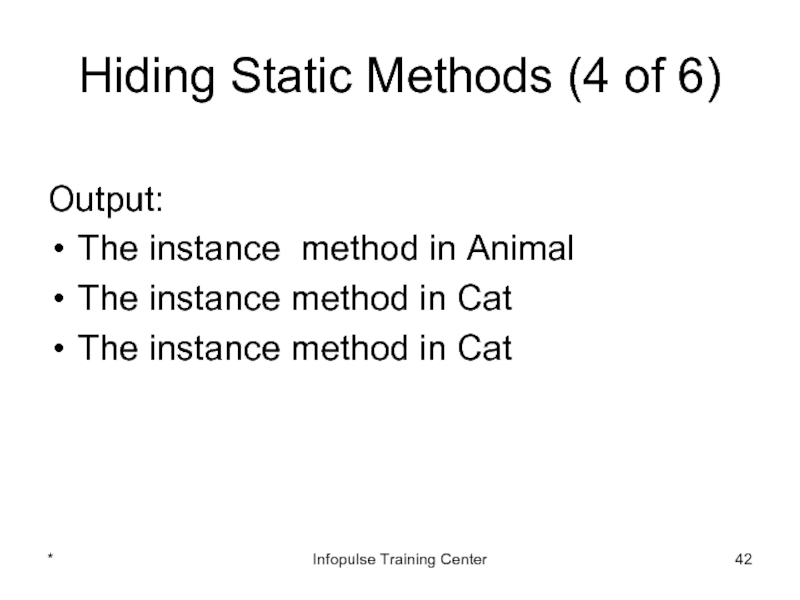
![Hiding Static Methods (5 of 6)public static void main(String[] args) { Animal myAnimal = new](/img/tmb/1/32371/82036f163dec4cff0e68e5d0408ced67-800x.jpg)
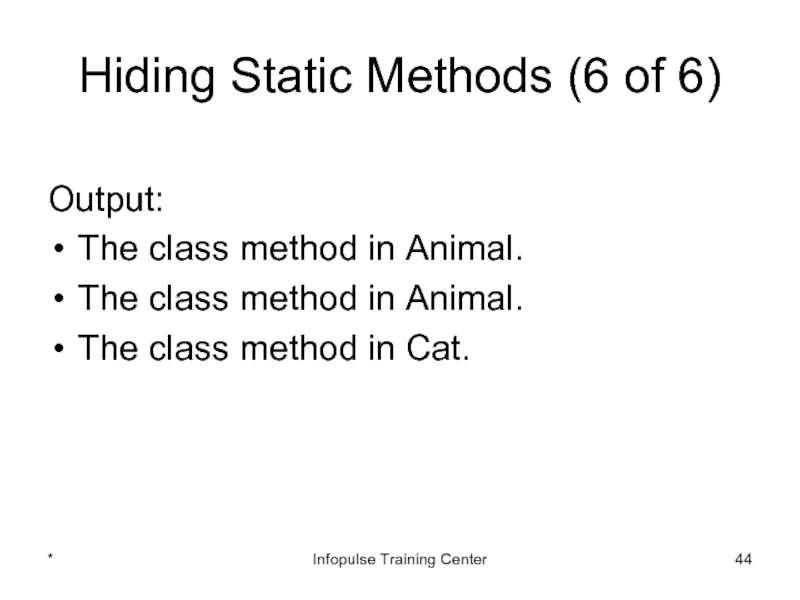
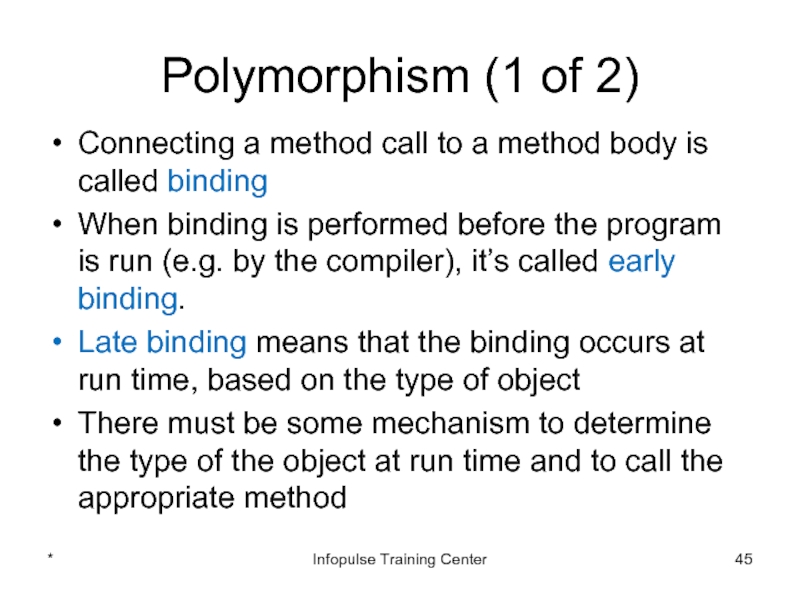
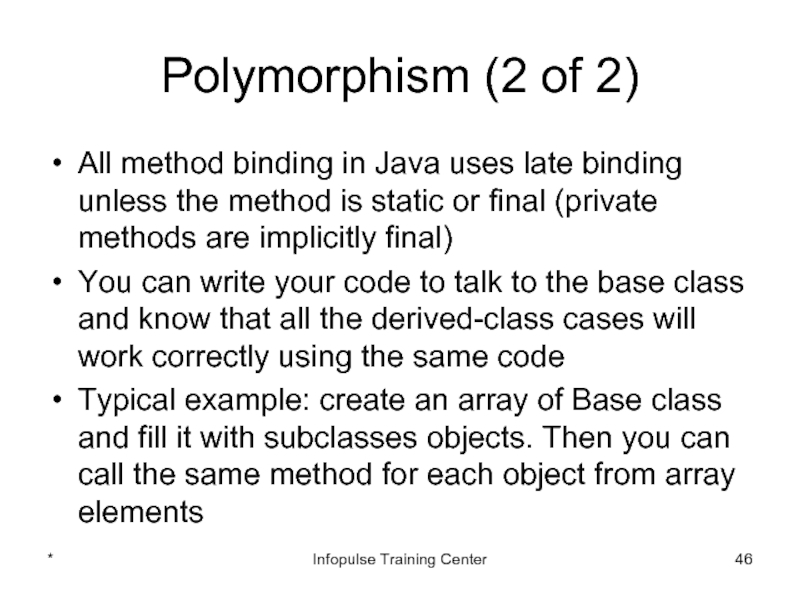
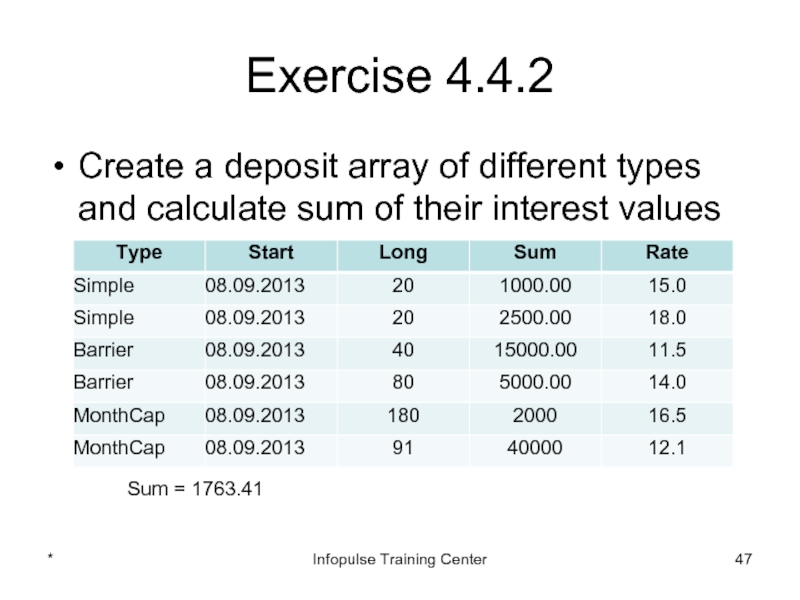
![Exercise: Interest Values SumDate start = new GregorianCalendar(2013, Calendar.SEPTEMBER, 8).getTime();DepoBase[] depo = new DepoBase[6];depo[0] =](/img/tmb/1/32371/010f22a2f68c7701aca9a1d508ff9eff-800x.jpg)
